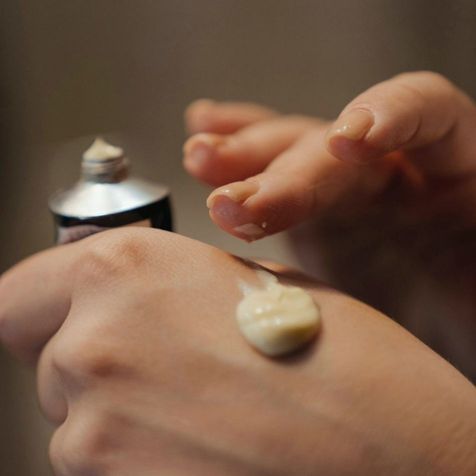PRENUMERERA & SPARA 20%
FRI FRAKT
Kommer du ihåg ditt lösenord?
Subscribe to receive a guaranteed shipment of formula every month.
Enjoy a {{ discount_amount }} discount on product throughout your subscription.
Change or cancel your subscription at any time!


Detta är den vanligaste varianten av rosacea. Symtomen är perioder av rodnad i delar, vanligtvis mitten, av ansiktet. Med tiden kan denna kroniska rodnad orsaka att blodkärlen under hudytan förstoras, vilket leder till permanent rodnad (erytem).
Denna typ innebär en permanent rodnad av huden med sporadiska finnar.
Denna typ kännetecknas av förstorade porer och rodnad som leder till en svullen, förstorad näsa.
Okulär rosacea resulterar i inflammation i de yttre delarna av ögat, med symtom som en torr känsla, rodnad runt ögonfransarna, ökad tårproduktion och vaglar.
Om du tror att du har rosacea bör du alltid gå till en hudläkare eller läkare för att få en korrekt diagnos.




Rosacea drabbar både män och kvinnor och vanligast är att det uppkommer efter 30-årsåldern. Ur ett globalt perspektiv så kan man se att det är betydligt vanligare att drabbas av rosacea om man kommer från de norra delarna av Europa.
Rosacea påverkar inte bara människor fysiskt utan också mentalt. Ny forskning visar att dess psykosociala påverkan kan vara mycket allvarlig och leda till social ångest och depression. Intressant nog tenderar män att uppleva värre psykologiska effekter än kvinnor.
Den exakta orsaken till rosacea är fortfarande okänd. Genetik verkar spela en roll, t ex innebär det att om din mamma har rosacea, är det mer sannolikt att du också får det. Rosacea har också ansetts vara kopplat till immunsystemets störningar och ökad nervkänslighet.
Det finns indikationer på att rosaceapatienter har högre nivåer av Demodex-kvalster (en typ av parasit) som lever i huden. Vi har alla ett antal kvalster i huden och kvalster trivs som många vet i både sängkläder och hud. Demodexkvalster kan även leva i våra hårsäckar och talgkörtlar. Enligt en teori utlöser deras avföring ett inflammatoriskt svar i vår hud.
Det finns också ett medicinskt samband mellan rosacea och autoimmuna sjukdomar som diabetes, celiaki (glutenintolerans) och reumatism.
Hudvårdsvanor kan också vara en orsak till rosacea. En stor studie visade att rengöringsvanor kan påverka uppkomsten och utvecklingen av rosacea. Överrengöring verkade vara en stor riskfaktor och vi har skrivit en sammanfattad artikel om denna mycket intressanta studie här.
Psykologisk stress verkar också vara en högt bidragande faktor till rosacea. Faktum är att hudläkare i Sverige rapporterade ett ökat antal rosaceafall under våren 2020, det vill säga under covid19-pandemin. Man tror att orsaken bakom denna ökade förekomst av rosacea beror på högre nivåer av psykologisk stress.


Det finns inget botemedel mot rosacea, men det finns flera behandlingar tillgängliga. Idag behandlas tillståndet ofta med antibiotika och aktuella läkemedel som har antiinflammatoriska egenskaper. Många av de som drabbas av mer allvarlig rosacea behöver ordineras behandling av en läkare. De viktigaste behandlingarna är:
Behandlingar som minskar rodnad, till exempel brimonidin och oxymetazolin. Dessa behandlingar minskar blodtillförseln till huden, så att huden inte rodnar så mycket. Brimonidin används också i ögondroppar för att behandla okulär rosacea..
Azelainsyra är en effektiv behandling mot rosacea, särskilt genom att den minskar överproduktionen av peptiden cathelicidin, som i överskott orsakar inflammation, rodnad och irritation i huden. Genom att hämma denna inflammatoriska process lindrar azelainsyra rosaceasymtom, vilket gör den till en viktig ingrediens i receptbelagda krämer som Finacea som innehåller 15% azelainsyra.
Antibiotika till exempel metronidazol och tetracykliner. Det är inte känt exakt varför antibiotika påverkar rosacea, men en möjlig förklaring är att antibiotika dödar bakterietillväxt i huden som potentiellt kan orsakas av kvalsters avföring.
Ivermektin, en insekticid som dödar Demodex-kvalster, är en av de nyare behandlingarna för rosacea.


Faktorer som kan påverka rosacea negativt
Vad som framkallar ett rosacea-utbrott är individuellt men för dig som har rosacea kan det vara bra att veta vad som kan göra besvären värre.
Men även kyla och blåsigt väder
Som graviditet, PMS, menstruation och klimakteriet
Som innehåller ämnen som kan irritera huden som t ex parfym, färgämnen eller konserveringsmedel samt vissa solskyddsmedel och kosmetika
Har man rosacea bör man undvika överdrivet solande eftersom det ofta förvärrar sjukdomen. Man bör också vara försiktig när man tvättar ansiktet och välja en mild rengöringsprodukt för känslig hud. Välj gärna en fuktkräm som inte är för fet och som är lugnande, stärkande och som stöttar hudens mikrobiom. Samtliga fuktkrämer som vi utvecklat passar för rosacea-benägen hud men viktigt att du söker råd hos läkare om du har allvarligare besvär.
Gillbro, J. (2019) Hudbibeln. Stockholm, Bookmark förlag.
Steinhoff, M., Schauber, J. & Leyden, J.J. (2013) New insights into rosacea Dermatology. [Online] 69 (6), S15–S26. Available from: doi:10.1016/j.jaad.2013.04.045.
Li, G., Wang, B., Zhao, Z., Shi, W., et al. (2020) Excessive cleansing: an underestimating risk factor of rosacea in Chinese population. Archives of Dermatological Research. [Online] Available from: doi:10.1007/s00403-020-02095-w.
Van Zuuren, E.J., Fedorowicz, Z., Carter, B., Van Der Linden, M.M., et al. (2015) Interventions for rosacea. Cochrane Database of Systematic Reviews. [Online] Available from: doi:10.1002/14651858.cd003262.pub5.
Gillbro, J.M., Lundahl, M., Westman, M., Baral, R., et al. (2015) Structural activity relationship analysis (SAR) andin vitrotesting reveal the anti-ageing potential activity of acetyl aspartic acid. International Journal of Cosmetic Science. [Online] 3715–20. Available from: doi:10.1111/ics.12253.